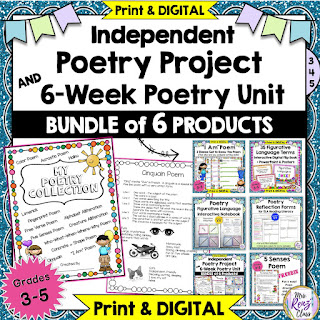It's April, do you know what that means? Yes it's the month of April Fool's Jokes, Taxes, Earth Day, and Easter, but did you know that April also happens to be National Poetry month?! I promise, it's a real thing. With it being National Poetry month, it's a great time to introduce your students to poetry and encourage them try their hand at creating their very own poems.
My love for poetry began long ago. As a kid, I remember my dad reciting (by heart) a Lewis Carroll poem,
The Walrus and the Carpenter. I was enthralled listening to his intonation and the voices he used as he recited the poem by heart. Each night I looked forward to bedtime just so I could hear my dad read poems and stories to me. Maybe that's where I developed a love of poetry!
You may be asking yourself, how do I help foster student learning and inquiry about poetry when they have little to no previous exposure? Years ago I created a wildly popular independent poetry unit that gives students the opportunity to read poetry from other poets and to try their hand at writing 11 different forms of poetry. I love it because in our pre-unit reflection, many students (especially the boys) aren't looking forward to writing poetry, some even groan and complain, and at the end they think writing poetry is pretty cool.
Poetry Unit Details On TpT
The unit is designed so that students are in control of the amount of points they earn through writing poems. In this unit, it's all about effort and trying new things. It's super easy for the teacher to implement and I've added a ton of other things to the set.
My best advice is to read poetry to your students every day! You can also do Reader's Theaters with poems.
Casey at the Bat by Ernest Lawrence Thayer makes a great Reader's Theater. Read all kinds of different poems from an array of authors. They will soon be asking you, "When can we write our own poems?"
I have selected a few classroom favorites by
Shel Silverstein to share with you to give you a jump start on poetry inspiration. I love poems that are funny to get students in grades 3-5 laughing and seeing how fun writing poetry is.
Read and write on!

















